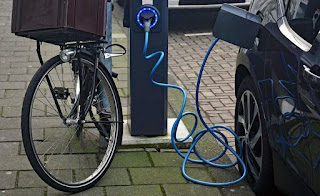In their efforts to discredit renewable energy and support continued fossil fuel burning, many anti-environmentalists have circulated a dual image purporting to compare a lithium mine with an oilsands operation. It illustrates the level of dishonesty to which some will stoop to keep us on our current polluting, climate-disrupting path (although in some cases it could be ignorance).
The image is a poor attempt to prove that lithium batteries and renewable energy are worse for the environment than energy from oilsands bitumen. The first problem is that the “lithium mine” is actually BHP Billiton’s Escondida copper mine in Chile (the world’s largest). The bottom image is of an Alberta oilsands operation, but it’s an in situ underground facility and doesn’t represent the enormous open-pit mining operations used to extract most bitumen.
Lithium is used in batteries for electric cars, cellphones, computers, and other electric devices, as well as power-grid storage systems, because it’s light and highly conductive. Most lithium isn’t mined. More than 95 per cent comes from pumping underground brine into pans, allowing the liquid to evaporate and separating out the lithium using electrolysis.
Any real comparison between oilsands and lithium batteries shows that oilsands products, from extracting and processing to transporting and burning, are by far the most destructive. Extraction and production destroy habitat, pollute air, land, and water and produce greenhouse gas emissions. Burning the fuels causes toxic pollution and wreaks havoc with Earth’s climate.
Does that mean batteries are environmentally benign? No. All energy sources and technologies have some environmental impact — one reason energy conservation is crucial. A 2010 study comparing the environmental impacts of electric cars to internal combustion vehicles found the latter are far more damaging, taking into account global warming potential, cumulative energy demand, and resource depletion. Battery components, including lithium, can also be recycled, and used electric car batteries can be repurposed to store energy for homes, buildings and power grids.
Lithium wasn’t found to be a major environmental factor for electric car batteries, but copper, aluminum, cobalt, and nickel used in the batteries have high impacts. Materials used to make other car components, for electric and internal combustion vehicles, also come with environmental impacts.
The energy sources used to charge car batteries also determine the degree of environmental impact. If coal is the main source, negative effects are much higher than if the power comes from hydroelectric or renewables such as wind and solar. But the impacts are still lower than fueling cars with gas.
Read more at Renewable Energy Isn’t Perfect, but It’s Far Better than Fossil Fuels

No comments:
Post a Comment